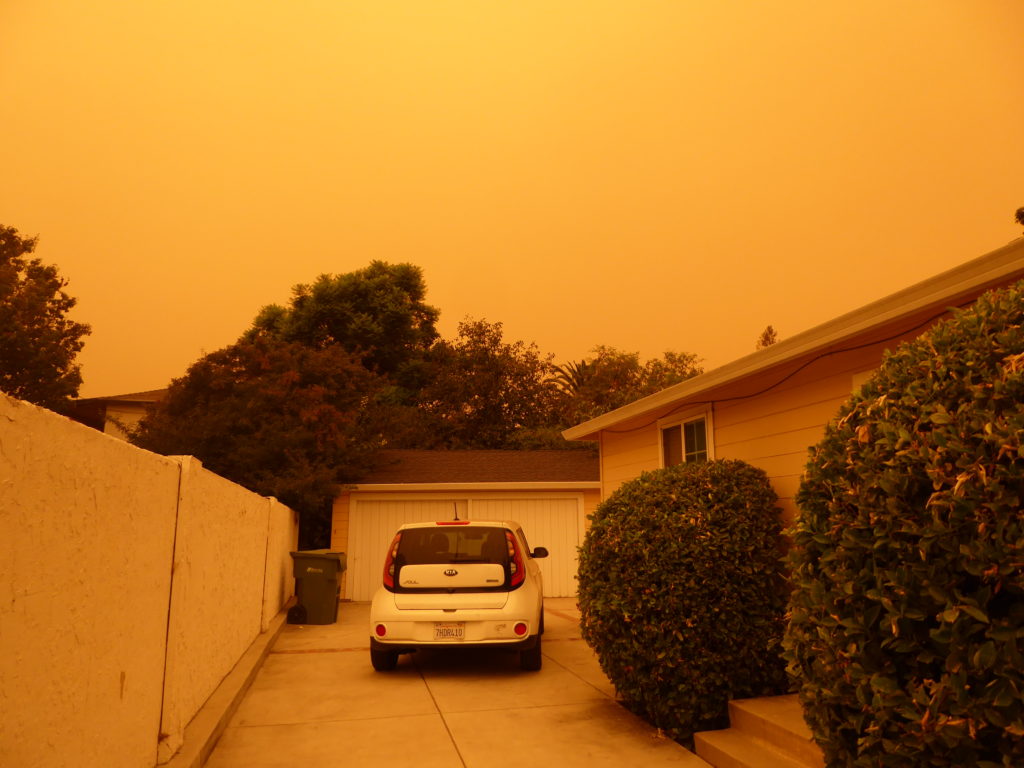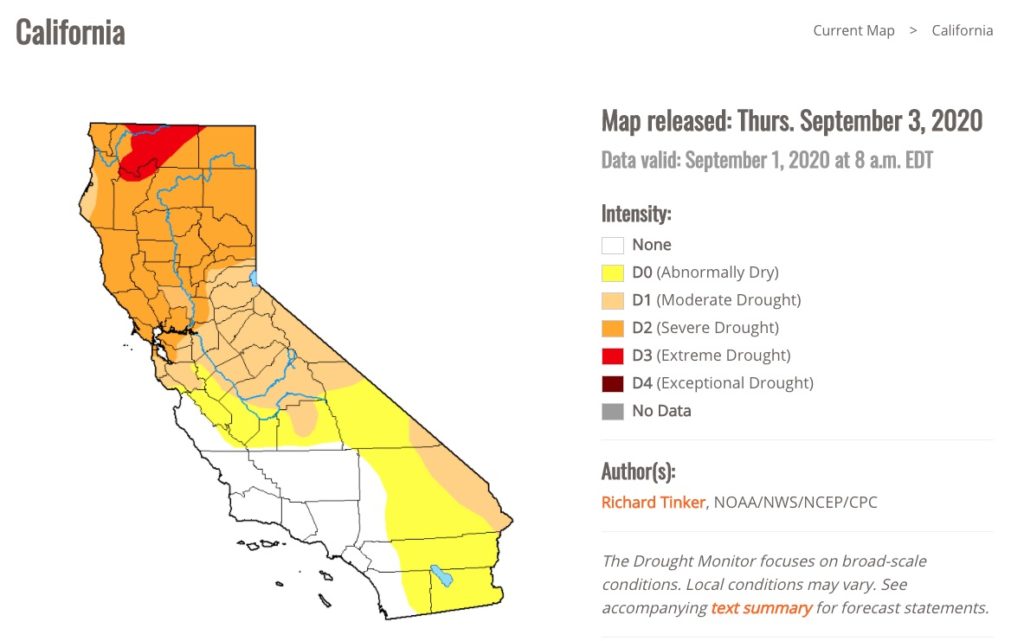The 2020 wildfire season in the Western USA (California, Oregon, etc) started early. Dozens of fires ignited one weekend in August leading to wildfires all around the state, and today four of the largest wildfires in California’s history are burning simultaneously. More recently a heatwave sparked other wildfires in not only California, but Oregon and Washington State. As you can see from this map, the total smoke plume from these fires extends well out into the Pacific Ocean, and today many areas woke up this morning to eerie orange skies that look like the end of the world.

In mid-August a series of freak summer storms rolled across California. This state almost never gets rain during the summer, and almost never has lightning storms. But in mid-August, following a couple weeks of severe heat, there was a large band of thunder/lightning storms across the state. These storms dropped almost no rain, but delivered a huge number of lightning strikes, and immediately sparked hundreds of fires in northern California.
The most significant of those fires was labeled LNULightningComplex (in Napa, Sonoma, Lake, Yolo and Solano Counties), SCULightningComplex (in Santa Clara, Alameda, Contra Costa, San Joaquin and Stanislaus counties), August Complex (Mendocino County), and CZULightningComplex (Santa Cruz and San Mateo Counties). Three of those were directly inside the SF Bay Area, and in some cases on terrain that had not burned for 70+ years. As of this writing the acreage consumed is:
- CZU Lightning Complex: 86,509 acres
- SCU Lightning Complex: 396,624 acres (#4)
- LNU Lightning Complex: 363,220 acres (#3)
- August Complex: 421,899 acres (#2)
Another fire, the Creek Fire, in the Sierra Nevada mountains near Fresno, was sparked in early September, in the midst of another severe heat-wave event, has burned 163,138 acres, and is #16 on the list of 20 largest California wildfires. That fire just started, is approximately 0% contained, and will surely grow significantly.
Another piece of context – the Camp Fire that in November 2018 destroyed the city of Paradise California is the deadliest fire of California’s history, burning over 18,000 structures (an entire city), and killing at least 85 people. At 153,336 acres it is currently #20 on the list of 20 largest California wildfires, and will surely fall off this list by 2021.
Over the last few years the weather here has been hotter, and drier, every year. In 2020, California had its driest February on record, with some areas of the state receiving zero rain in February. In California, there is generally no rain from April through November, and what water the state collects comes in the winter from rain and snowfall. That means, 2020 will end up with unseasonably low rainfall for the year, contributing to several years of low rainfall.

One measurable result is that a large portion of California is in severe drought conditions. Most of the fires that were sparked so far occurred in the areas marked as Severe Drought or Moderate Drought.
Drought of course means that plants and wildlife have a hard time with living. Further, it’s not just this year, but for several years much of California has been in severe drought conditions.

This tweet![]() by A. Poursaberi shows a map of dead trees per acre. Many years of dry weather has had its toll on California’s landscape.
by A. Poursaberi shows a map of dead trees per acre. Many years of dry weather has had its toll on California’s landscape.
I have annotated the map to show the approximate locations of the four largest fires so far this season in California. These four are burning simultaneously as I write this, and are among the 20 largest fires of California’s recorded history.
Let me repeat that, of the 20 largest wildfires of California’s history, four of them are burning right now in 2020, and the 2020 wildfire season has just begun. Historically the wildfire season ends when the rains start in mid-November, so as of this writing in early September we have two more months to go.
In any case, a dead tree has no innate resistance to burning. Therefore, those areas on the map with severe tree death are fire traps waiting to burn.
On the other hand, the natural pattern for California is for occasional lightning-sparked wildfires to clear the landscape of dead vegetation. Some species require fire in order for the seeds to germinate. According to the San Jose Mercury News![]() , the State of California and the US Forest Service (much of California is managed by the USFS) have signed an agreement to thin the forests with logging and controlled burns.
, the State of California and the US Forest Service (much of California is managed by the USFS) have signed an agreement to thin the forests with logging and controlled burns.
But it’s also clear that, since the overall climate is heating up, California will not any time soon see relief on the drought front. According to Climate Central![]() , the last five years have been the hottest five years on record, and the 10 hottest years globally happened within the last 15 years.
, the last five years have been the hottest five years on record, and the 10 hottest years globally happened within the last 15 years.
A big impact this sort of wildfire makes is to release carbon into the atmosphere. The trees had sequestered that carbon in the form of wood and leaves, and when the trees burn the carbon is released. That means not only is the smoke plume shown above a health hazard, it is a climate change hazard because it is worsening the carbon impact on the atmosphere.
- Is there enough Grid Capacity for Hydrogen Fuel Cell or Battery Electric cars? - April 23, 2023
- Is Tesla finagling to grab federal NEVI dollars for Supercharger network? - November 15, 2022
- Tesla announces the North American Charging Standard charging connector - November 11, 2022
- Lightning Motorcycles adopts Silicon battery, 5 minute charge time gives 135 miles range - November 9, 2022
- Tesla Autopilot under US Dept of Transportation scrutiny - June 13, 2022
- Spectacular CNG bus fire misrepresented as EV bus fire - April 21, 2022
- Moldova, Ukraine, Georgia, Russia, and the European Energy Crisis - December 21, 2021
- Li-Bridge leading the USA across lithium battery chasm - October 29, 2021
- USA increasing domestic lithium battery research and manufacturing - October 28, 2021
- Electrify America building USA/Canada-wide EV charging network - October 27, 2021






















Pingback: La Nina develops, promising longer 2020 fire and hurricane season – The Long Tail Pipe
Pingback: 5+ million acres burned, choking smoke, Climate Change accelerated – The Long Tail Pipe